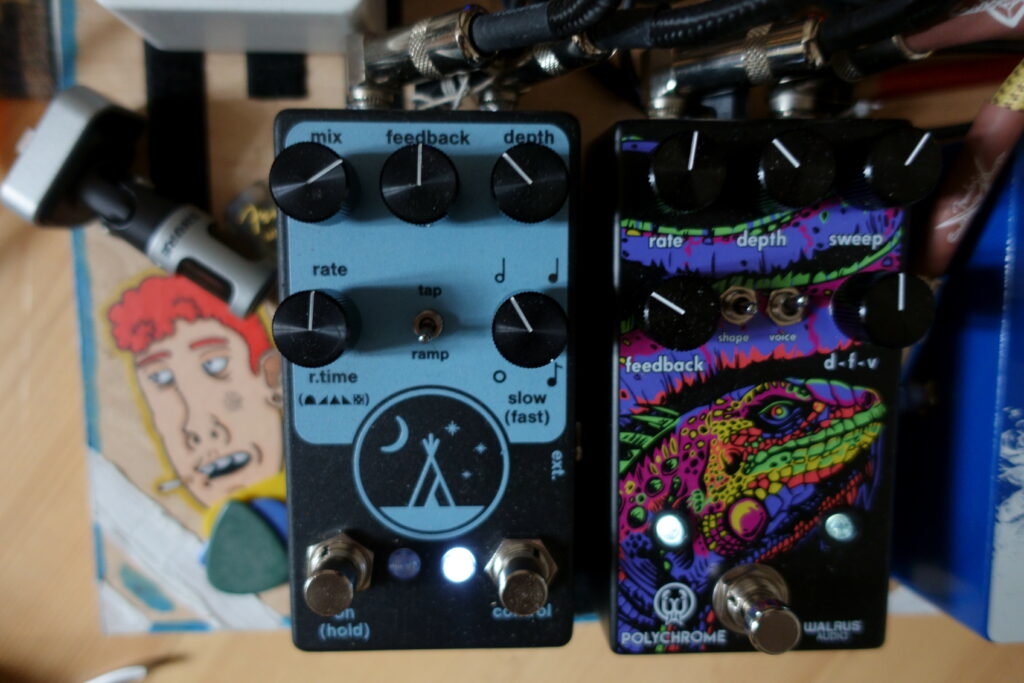Illustration: Filip Fröhlich
We (music producers) love gear and plugins.
We (guitarists) love pedals, sometimes a little bit too much, though there are worse problems to have. Last year, we explored the debate of analog vs. digital effects when it comes to guitar performance and recording. Today’s topic topic builds off of this in response to a question we’ve received a lot—what is the difference between a phaser, or phase shifter, and a flanger? In what contexts would a musician opt for one over another in live performance, or a producer opt for one over another in the DAW?
We’ll begin with the fundamentals.
What is a phaser?
Phasers generate a sound that’s full of movement and intensity. While there’s absolutely a “classic” phaser tone, in particular within the guitar world, the effect can become quite versatile through the manipulation of common parameters such as rate, feedback, and depth. Generally, phase shifters often evoke a feeling of the signal being sent to space, orbiting around some imaginary planet trapped inside the device and returning to the listener at a customizable BPM.
How a phaser works
Like most effects, this is being achieved through a number of steps. Phasers first manipulate the input signal using an all-pass filter, which may sound familiar to producers who are experienced with low-pass and high-pass filters. However, in this case, rather than identifying and then excluding certain frequencies, the all-pass filter will identify a specific frequency range to copy and move 90 degrees out of phase before combining back with the original signal.
When this happens, the resulting tone is not yet that which we know as a phaser, and that’s because phase effecting is generally pushing the input signal through at least two all-pass filters. Some products tout 10+ individual paths, in which slices of a signal are processed! We refer to this number of all-pass filters, whether it’s static to a particular product or customizable by the user, as the stage.
See the knob furthest on the right-hand side of the Boss PH-3 as an example. These numerical values are referring to the number of stages, or all-pass filters, that are being applied to the input signal when at that setting.
From this stage, the most common final step is the integration of a low-frequency oscillator, or LFO. Using this, often with at the very least a rate (Hz) and shape setting (such as sine, triangle, and so on), the LFO will “sweep” across the signal’s frequency ranges and bring us out into space. As the user tweaks individual settings (audio examples below), the signal’s notches and peaks will experience different types of octave cancellations, signal boosts, and more. The result of this crucial step is what we now know as a fundamental sound within the world of audio effects.
What is a flanger?
Still with me, I hope? The good news is that from here, understanding the second effect is generally easier.
There are many ways of imposing will on individual sonic qualities to interact with one another in and out of unison. We’ve just learned that in the case of a phaser, the only such quality being manipulated is based on individual frequency ranges. Flangers use similar modulation tricks to instead move time in and out of phase via a fractionally delayed signal blending with the original.
How a flanger works
Think if a delay pedal with a very subtle time setting were to output both the delayed sound as well as the dry signal. From this baseline effect, an LFO is often utilized for customization just as it was with a phaser (and for that matter, just as it is with many other effects such as chorus and vibrato).
We may begin to see why there’s confusion around the process as well as the output sound. Let’s have a listen to some examples in both analog and digital signal processing.
Phaser vs. flanger (in analog)
We ran a simple chord progression around 70 BPM, with a less time-bound introduction to allow for a bit more observance, through a few different settings on physical phaser and flanger pedals. These were recorded by a Rode NT-5 pair capturing a Fender Stratocaster through the Native Audio Midnight Phaser and the Walrus Audio Polychrome Analog Flanger.
When listening, really try to think about what’s being done to the signal. Can you begin to hear when individual frequencies copied from a signal are being pushed out of phase, and when marginally delayed copies of an entire signal are being pushed out of phase?
The below examples are captured in individual takes, so slight differences in expression are possible.
Dry signal—electric guitar

A peek at the settings for what you’ll hear below
Basic phase effect—Native Audio Midnight pedal
Basic flange effect—Walrus Audio Polychrome pedal

A peek at… What became not so realistic for a track, but somewhat fun to hear
Intense phase effect—Native Audio Midnight pedal
Intense flange effect—Walrus Audio Polychrome pedal
And for good measure, here are both pedals in neutral (noon or otherwise basic settings) positions
Hopefully, you can begin to understand not only how to identify the phase and flange sounds, but also what you actually like about the individual effects. When the modulation process is similar in so many ways, but imperatively different when one digs into the details, training your ear is key to help you decide between different effects in your music. If you’re a fellow guitarist who has written something you’re proud of using these effects, please write to me at mattbrooks.beratung@gmail.com.
Phaser vs. flanger (in digital)
For guitarists, it’s notable that effect processing takes place after an audio signal has been converted in real-time into electronic information for the pedal to manipulate. This differs from what we’ll explore at this point running samples—digital data which has already been processed and mixed—through iZotope’s Stutter Edit.
Using this plugin, which is available on Rent-To-Own with Splice, we’ll apply a phaser and flanger to a clean recording of a nylon string guitar, as well as a synth sample from the Noisia Sample Pack Vol. 2.
Dry signal—classical guitar
Stutter Edit’s phaser, based off of the “Wah Do You Say?” factory preset
Stutter Edit’s flanger, based off of the “Organ-ish” factory preset
Okay, enough of the guitars—let’s get a synth and some drums in here.
Stutter Edit’s phaser, based off of the “Phased Filter Movement” factory preset
Stutter Edit’s flanger, based off of the “Offset Flange” factory preset
While it would be impossible to encompass all of the possibilities of these effects in a few clips, hopefully all of these examples provide you with a starting point to distinguish the key differences between phasers and flangers. We highly recommend experimenting with your own sounds, and sharing what you make with us on Discord!
Conclusion
It makes sense that these effects are commonly mistaken for one another. With the right adjustments to settings, they can fool even experienced musicians, producers, and technically-informed listeners. What did Eddie Van Halen really use on “Ain’t Talkin’ ‘Bout Love” in 1978? Do I need a flanger to start a Rush cover band?
In the end, the better you know and connect with your physical gear and plugins, the more sincerely you can bring your voice to the world. Only you can bring your distinctive sonic brand, but the way you dress it up and present it to the world as a producer in part comes down to a technical understanding of effects like these. If you really like these sounds and bake them into your brand, you may just be approving your own custom shop phaser and flanger pedals before you know it!
Try Stutter Edit 2 for free, and then rent-to-own the plugin until you own it outright:
April 17, 2023

.svg)
.svg)




